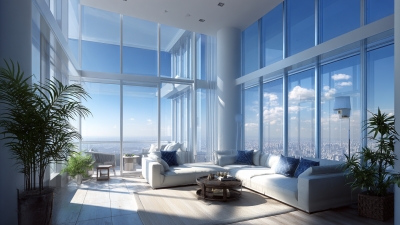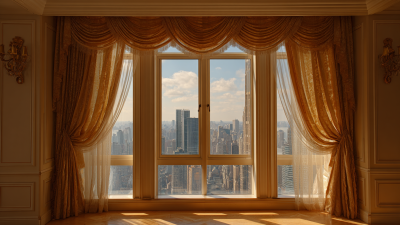Mastering the Art of Selecting the Perfect Sliding Doors and Windows for Your Space
 When it comes to enhancing the functionality and aesthetics of any space, the selection of
sliding doors and windows plays a crucial role. According to a report by
the National Association of Realtors, homes equipped with modern sliding glass doors and energy-efficient
windows can see an increase in resale value by up to 10%. These elements not only
create a seamless transition between indoor and outdoor environments but also promote
natural light and improved ventilation. Furthermore, a study by the
U.S. Department of Energy highlights that high-quality sliding doors and windows can significantly reduce
energy consumption, contributing to lower utility bills and a more sustainable living environment. As homeowners
seek to optimize their spaces, understanding the benefits and features of sliding doors
and windows becomes essential for making informed choices that enhance
comfort, style, and energy efficiency.
When it comes to enhancing the functionality and aesthetics of any space, the selection of
sliding doors and windows plays a crucial role. According to a report by
the National Association of Realtors, homes equipped with modern sliding glass doors and energy-efficient
windows can see an increase in resale value by up to 10%. These elements not only
create a seamless transition between indoor and outdoor environments but also promote
natural light and improved ventilation. Furthermore, a study by the
U.S. Department of Energy highlights that high-quality sliding doors and windows can significantly reduce
energy consumption, contributing to lower utility bills and a more sustainable living environment. As homeowners
seek to optimize their spaces, understanding the benefits and features of sliding doors
and windows becomes essential for making informed choices that enhance
comfort, style, and energy efficiency.
Table of Contents
[Hide]
Understanding the Types of Sliding Doors: A Comprehensive Comparison Guide
When it comes to selecting the perfect sliding doors for your space, understanding the various types available is essential. Sliding doors not only enhance the aesthetic appeal of a home but also improve functionality and space management. According to a recent industry report, sliding door installations have seen a significant increase, with a projected growth rate of 4.5% annually through 2025. This growth is largely attributed to their versatility in different architectural styles and their ability to create seamless transitions between indoor and outdoor living spaces.

There are several types of sliding doors to consider, including traditional sliding doors, bi-fold doors, and pocket doors. Traditional sliding doors typically consist of two panels that slide past one another, making them perfect for smaller spaces. On the other hand, bi-fold doors, which consist of multiple panels that fold away, are ideal for creating a wide opening, connecting your interior with expansive patios or gardens.
Pocket doors, which disappear into the wall when opened, are particularly useful in tight areas where space-saving solutions are necessary. Each type offers unique benefits tailored to various design needs, so it’s crucial to assess both the functional requirements and aesthetic preferences before making a selection.
Evaluating Energy Efficiency: Sliding Doors vs. Traditional Windows
When it comes to home design, one of the key considerations is energy efficiency, particularly when comparing sliding doors and traditional windows. According to the U.S. Department of Energy, up to 30% of a home's heating and cooling energy can be lost through inefficient windows and doors. Sliding doors, often featuring larger glass panels, can allow for greater natural light, which can reduce reliance on artificial lighting and lower energy costs. However, the energy performance of sliding doors can vary significantly depending on the type of glass and frame used.

Recent reports from the National Association of Realtors indicate that high-quality sliding doors can achieve a lower U-factor and solar heat gain coefficient (SHGC) compared to traditional windows. For instance, Energy Star rated sliding doors can significantly improve a home’s energy efficiency, with some products having U-factors as low as 0.17, rivaling or surpassing traditional windows. Furthermore, the integration of double or triple glazing in sliding glass doors can enhance thermal insulation, making them a practical choice for homeowners seeking to balance aesthetics with energy savings.
Material Matters: Comparing Vinyl, Wood, and Aluminum for Durability
When considering the selection of sliding doors and windows, the choice of material plays a crucial role in both durability and aesthetic appeal. The U.S. gates market is projected to grow significantly, with a robust analysis indicating that aluminum, steel, PVC/vinyl, and wood are the leading materials influencing consumer preferences. Aluminum, known for its strength and lightweight properties, offers excellent resistance to weathering and corrosion, making it a favorite in both residential and commercial applications. Conversely, wood presents a classic appeal with its natural beauty, but requires more maintenance to ensure its longevity.
In the context of modern design, the variety of materials used in products, such as those from innovative brands, highlights the potential for unique aesthetics beyond the usual plastic and glass. Materials like fiberglass and ceramic are gaining traction, showcasing their durability and design flexibility. Understanding these trends can empower homeowners to select the best options for their remodeling needs. As the market evolves, incorporating durable and visually appealing materials can enhance both functionality and curb appeal, making a significant impact on property value.
Aesthetic Appeal: Selecting the Right Style for Your Home's Design
When choosing sliding doors and windows, the aesthetic appeal must align with your home's overall design scheme. The right style can enhance the architecture while providing a seamless connection between indoor and outdoor spaces. Consider the material and finish; for instance, sleek aluminum frames often suit modern homes, while rich wooden frames can add warmth to traditional interiors.
Tip: Explore various styles like contemporary, mid-century, or rustic to see which resonates with your vision. Additionally, don’t shy away from experimenting with color—bold hues can serve as a striking focal point, while neutral tones provide understated elegance.
Another important consideration is the size and scale of your sliding doors and windows. Oversized openings can create dramatic effects and flood your space with natural light, but ensure they are proportionate to the surrounding architecture to maintain balance.
Tip: Before making a decision, visualize your space by using digital design tools or creating mood boards. This will help you see how different styles and finishes can impact the overall aesthetic of your home.
Mastering the Art of Selecting the Perfect Sliding Doors and Windows for Your Space - Aesthetic Appeal: Selecting the Right Style for Your Home's Design
| Feature | Sliding Doors | Windows |
|---|---|---|
| Material Options | Aluminum, Vinyl, Wood | Vinyl, Aluminum, Wood |
| Style Variations | Classic, Modern, Contemporary | Casement, Double-Hung, Bay |
| Energy Efficiency | Low E Glass, Insulated Frames | Low E Glass, Argon Gas Fill |
| Security Features | Multi-Point Locking System | Secure Lock Mechanisms |
| Customization Options | Colors, Handles, Patterns | Shapes, Grids, Colors |
| Maintenance Requirements | Low, Easy to Clean | Moderate, Requires Regular Cleaning |
Cost Analysis: Long-term Savings with Quality Sliding Doors and Windows
When selecting sliding doors and windows, it's essential to consider not just the upfront cost but also the long-term savings they can provide. Quality sliding doors and windows can significantly reduce energy consumption, leading to lower utility bills. For example, energy-efficient models often feature double or triple glazing, which provides excellent insulation. This means that during the hot summers and cold winters, your heating and cooling systems won't have to work as hard, translating to substantial savings over time.
Moreover, investing in high-quality materials can minimize maintenance costs. While cheaper alternatives might seem attractive initially, they often require frequent repairs or replacements, which can add up quickly. Quality sliding doors and windows are built to withstand weather changes, resist wear and tear, and maintain their aesthetic appeal. By choosing durable options, homeowners not only enhance their space's aesthetic but also secure a long-term investment that pays off through reduced maintenance and replacement costs. Ultimately, the right selection can lead to both immediate comfort and enduring economic benefits.
Cost Analysis: Long-term Savings with Quality Sliding Doors and Windows
Related Posts
-

Navigating Challenges with Sourcing French Windows for Global Buyers
-

Exploring Unique Alternatives to Traditional Big Windows for Modern Spaces
-

Top Strategies for Sourcing Stylish Windows in a Competitive Global Market
-

Solutions for Boosting Energy Efficiency with Fiberglass Doors: Industry Insights and Data
-

Innovative Examples of Interior Doors Transforming Modern Spaces with Industry Insights
-

Innovative House Door Designs That Transform Your Home and Boost Energy Efficiency